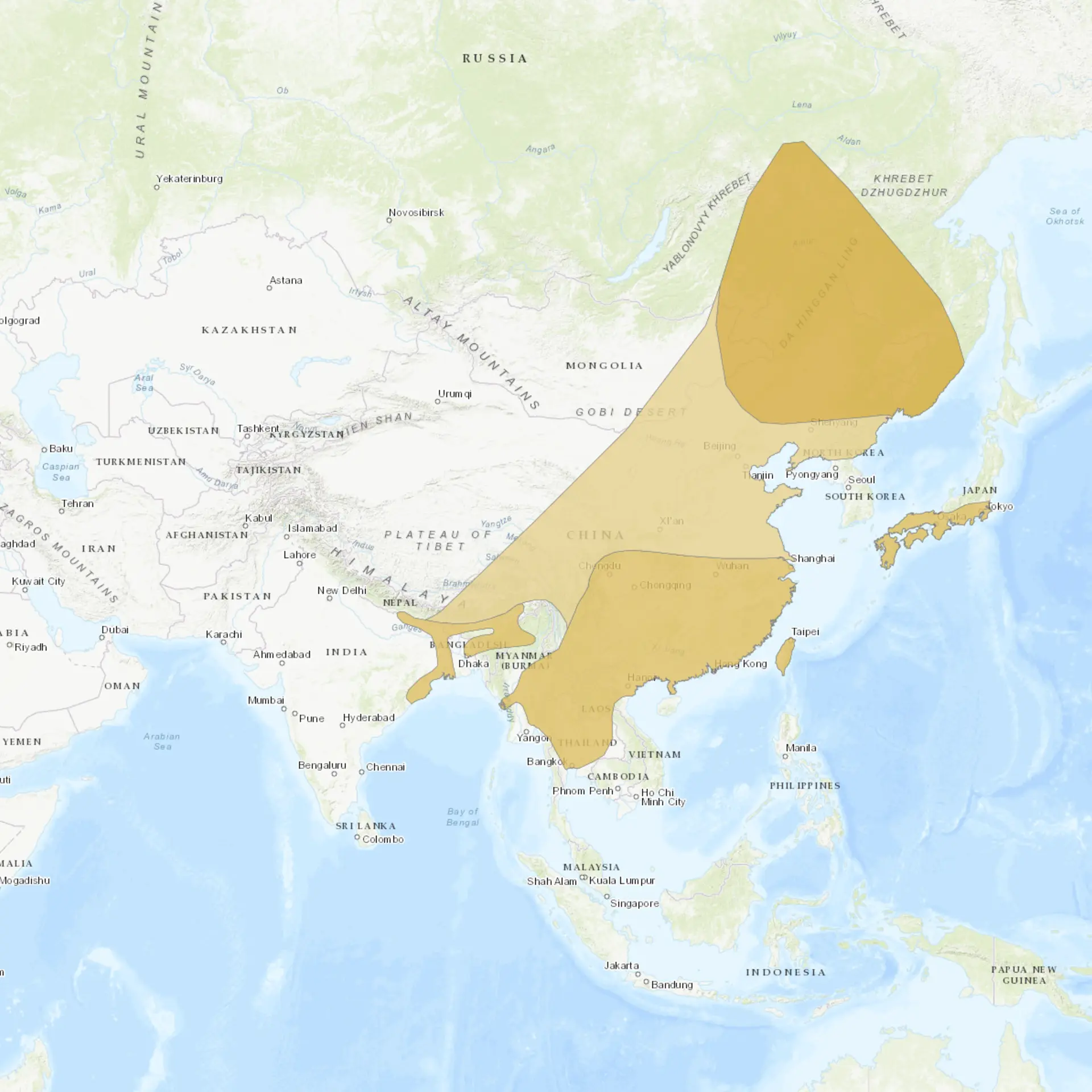Overview
Baer’s pochard (Aythya baeri) is a critically endangered diving duck native to East Asia, particularly found in freshwater wetlands and lakes. This medium-sized duck is easily recognized by its striking plumage, with males sporting a dark green-black head, chestnut-brown sides, and white underparts, while females are duller with mottled brown coloring. The species is migratory, breeding in northeastern China and southeastern Russia and wintering in parts of southern China, northern India, and Southeast Asia. Habitat loss, hunting, and disturbance have led to a catastrophic decline in its population, making it one of the most threatened waterfowl species in the world.
Baer’s pochard relies heavily on well-vegetated freshwater wetlands for breeding and foraging, favoring shallow lakes and ponds with abundant aquatic plants and invertebrates. During migration and winter, it inhabits larger lakes, reservoirs, and marshlands, forming mixed flocks with other diving ducks. Known for its diving ability, it feeds primarily underwater, using its webbed feet to propel itself in search of food. Despite its unique ecological role, the species is rarely seen in the wild today, with its population continuing to decline across its range.
Conservation efforts for Baer’s pochard are underway, with breeding programs in captivity and habitat restoration projects aimed at reversing its decline. Its rapid population reduction has highlighted the urgent need for international collaboration to protect wetlands across its migratory range. Raising awareness about this elusive species and enforcing stricter hunting regulations are critical to its recovery. Without immediate action, Baer’s pochard faces an uncertain future, and its survival depends on addressing the root causes of its decline.
Taxonomy
Kingdom
Phylum
Class
Order
Family
Genus
Species
Type
Current distribution:
Baer’s pochard has a highly fragmented and restricted distribution. Its breeding range is limited to northeastern China and southeastern Russia. Historically, the species was also bred in parts of Mongolia and the Korean Peninsula, but these populations are now considered extinct. During migration and winter, it travels to southern China, northern India, Myanmar, Bangladesh, and Southeast Asia, although sightings are increasingly rare. Key wintering sites include Poyang Lake and Dongting Lake in China, but even these areas now host only a few individuals.
The wild population of Baer’s pochard is critically low, with fewer than 1,000 individuals estimated to remain in the wild. Most sightings occur in a few scattered wetlands, and the species is now largely absent from many parts of its historical range. Captive populations exist in zoos and breeding facilities, offering hope for reintroduction efforts in the future. However, the continued loss and degradation of wetlands across its migratory range present significant challenges to its recovery.
Physical Description:
Baer’s Pochard males in breeding plumage are known for their striking appearance, with a glossy green-black head, bright red eyes, and a unique chestnut breast. The rest of their body is primarily a mix of black and white, with dark backs and wings contrasting with white flanks and underparts. Non-breeding males and females are more uniformly brownish-grey but retain distinctive red eyes. They are medium-sized ducks with robust bodies and relatively large heads, adapted for their diving lifestyle.
These ducks typically measure about 41-46 cm long and have an approximately 70-80 cm wingspan. Their strong, compact bodies enable them to dive efficiently, reaching depths where they can find aquatic plants and invertebrates. In flight, they reveal white underwings and a rapid wingbeat, distinguishing them from similar species. Juveniles resemble females but may have less distinct coloring and patterning.

Lifespan: Wild: ~10 Years || Captivity: ~20 Years

Weight: Male: 1.5-2.2 lbs (700-1,000 g) || Female: 1.3-1.9 lbs (600-850 g)

Length: Male & Female: 16-18 in (41-46 cm)

Wingspan: Male & Female: 27-31 in (70-80 cm)

Top Speed: 50 mph (80 km/h)
Native Habitat:
Baer’s pochard inhabits freshwater wetlands, including shallow lakes, marshes, and ponds with abundant vegetation and open water. During the breeding season, it favors densely vegetated wetlands in temperate regions, primarily in northeastern China and southeastern Russia. These habitats provide ample cover for nesting and a rich food supply, such as aquatic plants and invertebrates. The duck builds its nest among reeds or on floating vegetation near the water’s edge, relying on the surrounding wetland for protection from predators.
The species migrates to more southerly regions in winter, inhabiting larger lakes, reservoirs, and slow-moving rivers. Wetlands with abundant aquatic vegetation and minimal human disturbance are critical for survival during migration and wintering periods. Habitat loss due to agricultural expansion, dam construction, and drainage of wetlands has drastically reduced the availability of suitable sites across its range. Preserving intact wetlands is essential to maintaining viable populations of Baer’s pochard in the wild.
Climate Zones:
Biomes:
Biogeographical Realms:
Continents:
Diet:
Diet & Feeding Habits:
Baer’s pochard is an omnivore with a diet of aquatic plants, seeds, and small invertebrates. It forages underwater by diving and using its bill to sift through mud and vegetation, often consuming submerged plant matter like pondweed and watermilfoil. In addition to plants, it preys on small aquatic animals such as snails, insect larvae, and crustaceans, which provide essential protein during the breeding season. Its foraging strategy involves short dives lasting several seconds, with frequent pauses to surface and breathe.
During migration and winter, its diet may shift based on available food resources, with a higher reliance on seeds and aquatic vegetation in some areas. Baer’s pochard often forages in small groups or mixed flocks with other diving ducks, taking advantage of food-rich wetland habitats. Its diet is supplemented with grains, leafy greens, and small insects in captivity to replicate its natural feeding habits. Access to clean, undisturbed wetlands is crucial for its survival, as the degradation of these habitats directly impacts food availability.
Mating Behavior:
Mating Description:
Baer’s pochard forms monogamous pairs during the breeding season in late spring and early summer. Males engage in courtship displays, including head bobbing, wing flapping, and vocalizations, to attract females. Once paired, the female selects a nesting site among dense reeds or floating vegetation near shallow water. The nest is constructed using plant material and lined with down feathers for insulation.
Females lay a clutch of 7 to 12 eggs, which are incubated solely by the female for about 25 to 28 days. During this time, the male may remain nearby to guard the nesting territory but does not assist in incubation. After hatching, the ducklings are precocial and leave the nest within a day, following their mother to the water. The female provides care and protection until the ducklings can feed independently, which occurs after several weeks.
Reproduction Season:
Birth Type:
Pregnancy Duration:
Female Name:
Male Name:
Baby Name:
Social Structure Description:
Baer’s pochard is a social bird that forms small flocks during migration and winter, often mixing with other diving duck species, such as tufted ducks and common pochards. During breeding, pairs separate from flocks and establish territories in secluded wetland areas. Communication within flocks includes vocalizations and body movements, which help maintain cohesion and alert individuals to potential threats.
The female primarily provides parental care and remains with the ducklings until they become independent. Individuals rely on flocking behavior outside the breeding season to protect and locate food sources in shared habitats. The species’ reliance on group dynamics makes the preservation of healthy, undisturbed wetlands critical to maintaining their social structure and survival.
Groups:
Conservation Status:
Population Trend:
The global population of Baer’s pochard has declined catastrophically over the past few decades, with fewer than 1,000 individuals estimated to remain in the wild. Habitat loss, driven by wetland drainage, agricultural expansion, and urbanization, is the primary factor behind this decline. Hunting and egg collection have further exacerbated population losses, particularly in areas where enforcement of wildlife protection laws is weak. The species’ fragmented distribution and low numbers make it highly vulnerable to extinction, especially in the face of ongoing threats.
Captive populations of Baer’s pochard are being maintained in breeding programs to safeguard against total extinction and support potential reintroduction efforts. Conservation organizations are working to protect and restore key wetland habitats, focusing on areas critical to the species’ breeding and wintering cycles. Public awareness campaigns aim to reduce hunting and disturbance while promoting sustainable wetland management practices. Despite these efforts, the species remains on the brink of extinction, requiring urgent and coordinated international action.
Population Threats:
The primary threat to Baer’s pochard is habitat loss, as wetlands are drained, converted to agriculture, or degraded by human activity. Large-scale infrastructure projects, such as dam construction and water diversion, have further disrupted wetland ecosystems. Despite legal protections, hunting for meat, sport, and egg collection continues to pose a significant threat in some areas. Pollution and introducing invasive species have also reduced food availability and suitable nesting sites.
Climate change is an emerging threat, with rising temperatures and altered precipitation patterns impacting wetland habitats. The fragmentation of the species’ remaining populations makes it difficult for individuals to migrate and find suitable breeding or wintering sites. Conservation efforts are hampered by the lack of data on population dynamics and migration patterns and limited resources for enforcing wetland protection. Without significant intervention, these combined threats could lead to the extinction of Baer’s pochard in the wild.
Conservation Efforts:
Conservation efforts for Baer’s pochard focus on habitat protection, captive breeding, and public education. Protected areas, such as Dongting Lake and Poyang Lake in China, are critical for the species’ survival and provide key wintering habitats. Habitat restoration projects aim to rehabilitate degraded wetlands and improve water quality, ensuring sufficient food and nesting sites. Anti-poaching initiatives, including stricter enforcement of hunting regulations, are being implemented to reduce human-induced mortality.
Captive breeding programs, managed by zoos and conservation organizations, are working to maintain genetic diversity and produce individuals for potential reintroduction. International collaboration is essential, as the species’ migratory behavior requires coordinated efforts across multiple countries. Public awareness campaigns highlight the ecological importance of Baer’s pochard and the need to protect wetlands, fostering community involvement in conservation. While these efforts offer hope, the species’ recovery depends on addressing the root causes of wetland degradation and protecting critical habitats.
Additional Resources:
Fun Facts
- Baer’s Pochard is named after Karl Ernst von Baer, a pioneering naturalist who first described the species.
- They are known for their diving ability, often disappearing underwater for extended periods to forage for food.
- The striking red eyes of Baer’s Pochard are one of their most distinctive features, easily noticeable even from a distance.
- Despite their critical status, Baer’s Pochard is relatively unknown compared to other endangered birds, partly due to its elusive nature and remote habitat preferences.
- Conservationists sometimes use “flagship species” like Baer’s Pochard to raise awareness and support for protecting wetland habitats and biodiversity.
- Their migration patterns and routes are poorly understood, making it challenging to protect them throughout their annual cycle.
- The dramatic decline of Baer’s Pochard is considered one of the most rapid for any bird species in recent history.
- In some cultures, Baer’s Pochard is valued for its meat and eggs, contributing to hunting pressures in certain parts of its range.
- Ongoing research aims to uncover more about their secretive lifestyle, providing crucial insights for their conservation.
- Captive breeding programs for Baer’s Pochard are considered a last resort to prevent extinction.

















































































